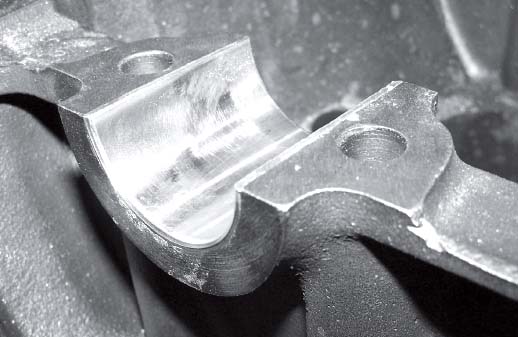


A Ford Model A babbitt bearing before its surface is smoothed with a boring bar and cutter. A frame is centered on the Model A engine to guide the boring bar as it spins in the babbitt bearings for the crank.
Engine bearings have come a long way since the early babbitt bearings, but that doesn’t make a lick of difference to the restorer of a prewar car. When it comes to rebuilding a prewar engine, restorers often prefer original babbitt bearings to the modern insert bearings, and places such as Metal Crafters in Stevens Point, Wis., are happy to accommodate those restorers. The company rebuilds dozens of engines each year, with a specialty in Ford Model T and Model A engines. These engines all originally used babbitt bearings, of course, and Metal Crafters engine specialist and owner Joe Thorn, as well as shop worker Troy Hermann, are both very capable of pouring these old-time bearings.

The installed babbitt bearing after a boring bar with a cutter has passed over the surface. Although it appears smooth, there are tiny grooves in the bearing surface that may allow oil to pass. Lapping will make this surface even smoother.
Since babbitt bearings are poured to form the bearing surface the crankshaft and camshaft spin against, the bearing surface must be cut smooth after they are poured. For this task, Metal Crafters uses a machine that holds the engine block in place while a boring bar fitted with a cutter removes material from the babbitt bearing until it has a smooth surface. The boring bar makes three passes with a rough cut, measuring cut and final cut to produce the desired bearing surface.
Although this method produces a very smooth surface that provides an engine with years and miles of longevity that exceeds Ford’s original method of preparing the surface of babbitt bearings, oil may still pass through the tiny grooves in the bearing surface, and the engine may not run at its smoothest.
Metal Crafters customer Bill Edstrom is a Model A Ford owner (an A-400) who is familiar with the oil leaks of a Model A engine with babbitt bearings, and the somewhat lengthy break-in period of an engine with new bearings. His engineering background often sends him searching out improvements, and he recently turned his attention to the crankshaft bearings of his A-400’s engine, which just received new babbitt bearings at Metal Crafters. After the cutting process, Bill wanted his Model A engine’s crankshaft bearings lapped, so he used Timesaver-brand lapping material to further smooth the surface of his engine’s bearings. This should reduce the oil loss and break-in time, as well as make the engine run a little smoother.

The Timesaver lapping material is mixed with oil. The instructions call for a specific ratio of oil to lapping material.

The Timesaver lapping material used in the lapping process comes in four grits: 40 through 100.
It should be noted that most lapping materials contain metal particles, which will destroy babbitt bearings and thus wreck an engine. Timesaver, the lapping compound used in this project, is specifically made for lapping babbitt bearings. It is made of crushed food products and does not contain metal particles. It is also self-diminishing and does not imbed itself in the babbitt bearings, which would destroy these bearings.

The crank is placed in position, the crank bearing caps are installed and then the crank is manually turned so the lapping compound can carefully and slowly grind the surface smooth.

The bearing surface has been made smoother after the 80- and then 100-grit lapping material passed over the surface. Engine machinist Troy Hermann will now verify that the bearing and crank tolerances all line up so when they are installed, all the parts are properly mated to work smoothly.

The lapping material and oil mix is spread with a brush over the babbitt bearing surface of one bearing at a time. The other bearing surfaces are coated with oil so they don’t get dry.
In this instance, the lapping compound is mixed with oil, per the instructions on the container, to make the compound like a gritty lubricant. That lubricant-like lapping compound is spread on the babbitt bearings, and then the moving part is put into position and turned (in this case, the part is the crankshaft or camshaft). The lapping compound takes away the high areas on the bearing to make the surface smoother.
The accompanying photographs show the lapping process on the A-400 engine’s crankshaft bearings. Detailed information, including measurements and warnings, can be found in the product’s instructions. Be sure to follow these instructions carefully to prevent damaging engine components.
SOURCE:
Metal Crafters
2701 Chamber St., Stevens Point, WI
715-341-3461